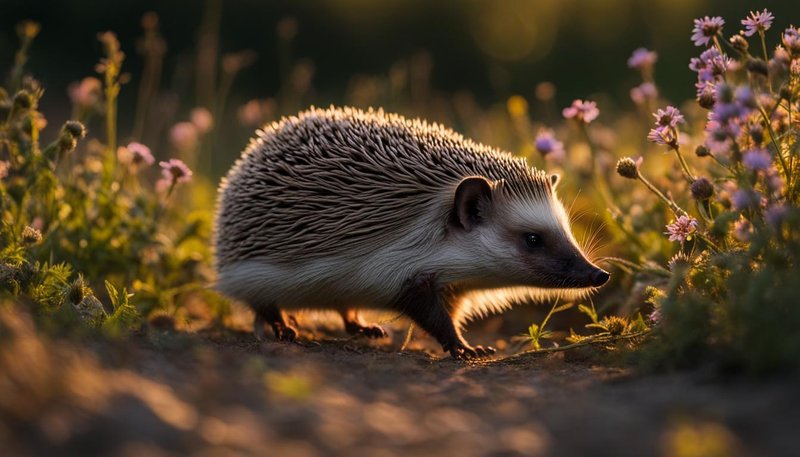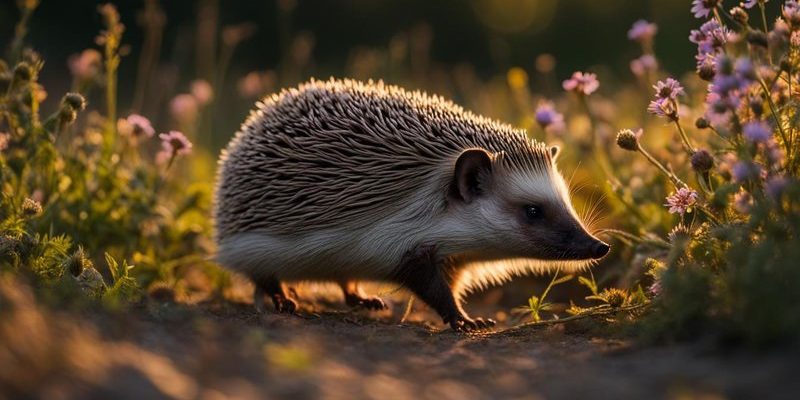
In this article, we’ll explore the *diet and hunting strategies* of hedgehogs in detail. We’ll learn what they eat, how they find food, and the various methods they use to hunt down their meals. If you’ve ever watched one of these little guys in action or thought about keeping one as a pet, you’ll find the information here not only interesting but also crucial for understanding the needs of these quirky animals.
What Do Hedgehogs Eat?
Hedgehogs are omnivores, which means they eat both plants and animals. Their diet mainly consists of insects like beetles, caterpillars, and slugs. Think of hedgehogs as the cleanup crew of your garden, munching on pests that can damage your plants. In fact, a single hedgehog can consume around 2,000 insects in one night!
These little creatures also enjoy other forms of protein. They are known to snack on small animals like frogs and even bird eggs. You might be wondering, “What about fruits and vegetables?” Hedgehogs do nibble on them sometimes; they have a soft spot for ripe berries and fallen fruits. However, these should only make up a small part of their diet. Too much fruit can lead to health issues, just like how too many sweets can be bad for us.
In a pet setting, you might be thinking about what to feed your hedgehog. There are specially formulated diets available, often made up of high-protein kibble or pellets. Just make sure to avoid cow’s milk and other dairy products, as hedgehogs can be lactose intolerant.
Hedgehog Hunting Techniques
Now that we’ve covered what hedgehogs eat, let’s dig into how they hunt for their food. One of their most fascinating hunting strategies is their incredible sense of smell. Hedgehogs have a keen nose that helps them detect insects even when hiding under leaves or soil. Imagine being in a treasure hunt, but your map is your nose—this is how hedgehogs navigate their world!
Another unique feature of hedgehogs is their ability to listen for movement. Their large ears help them pick up high-pitched sounds made by insects as they scuttle about. When a hedgehog hears a snack moving, it can easily tilt its head and pinpoint the direction, like a finely tuned radar system.
When it comes to catching their prey, hedgehogs can be surprisingly agile. They use their sharp claws to dig and uncover hidden insects. If you’ve ever seen a hedgehog roll into a tight ball, it may look defensive, but it actually also protects them while they investigate potential meals! This nifty move keeps them safe as they explore.
The Role of Spike Defense in Hunting
You might be curious about how a hedgehog’s spikes play into their feeding habits. While these spines are a fantastic defense mechanism against predators, they also have a role when it comes to hunting. When a hedgehog encounters a predator, it rolls into a ball, presenting a prickly exterior that deters many would-be attackers.
However, when it comes to hunting, those spikes aren’t a hindrance. Hedgehogs have learned to navigate through brush and thickets to hunt for food while using their sharp sense of smell and hearing. This adaptability is crucial since their hunting ground often includes dense foliage where insects love to hide. The spikes grant them safe passage, allowing them to get up close to their dinner without fearing larger predators lurking nearby.
Nighttime Activity and Hunting Patterns
Hedgehogs are primarily nocturnal creatures, meaning they are most active at night. Picture yourself at a cozy nighttime picnic; that’s how hedgehogs feel when they explore their surroundings under the cover of darkness. The reason for this is that many of their favorite snacks, like insects, are also out and about after sunset.
When nighttime falls, hedgehogs follow a routine that ensures they make the most of their foraging time. They wander anywhere from 1 to 3 kilometers (about 0.6 to 1.9 miles) per night, using their sense of smell and hearing to locate food. Honestly, it’s almost like they’re on a nighttime adventure, interacting with the world in complete darkness, relying on instincts honed over generations.
Since they can cover quite a distance in their search for food, it’s essential for hedgehogs to find safe environments with plenty of hiding spots and food sources. As gardeners or pet owners, understanding their nighttime habits can help us create a safer habitat for them, whether it’s a hedgehog-friendly garden or a comfortable indoor space.
Seasonal Changes in Diet
Just like we might change our dining habits with the seasons, hedgehogs also adapt their diets according to what’s available throughout the year. In the spring and summer, when insects thrive, hedgehogs feast on a buffet of creepy crawlies. They can be quite the little gourmets, savoring the assortment of delectable bugs.
As autumn rolls in, hedgehogs start to prepare for hibernation, which usually begins in late October or early November. During this time, they eat more to build their fat reserves. You might notice them foraging more aggressively as they bulk up. This is crucial, as fat reserves will sustain them during their extended sleep.
However, come winter, food becomes scarce. The ground is often too cold for insects to survive, so hedgehogs may enter a deep hibernation, living off their stored fat. If you ever find a hedgehog wandering around during the winter, it might be a sign that it’s struggling to find enough food.
Common Myths About Hedgehog Diets
There are plenty of misconceptions about what hedgehogs should or shouldn’t eat. One common myth is that hedgehogs enjoy milk or dairy products. In reality, many hedgehogs are lactose intolerant, and consuming dairy can lead to digestive problems. So, if you’re considering feeding a hedgehog, steer clear of the milk!
Another myth is that hedgehogs can eat cat or dog food exclusively. While it can be a convenient option for pet owners, it should only be a part of their diet. The main ingredients in commercial pet food may not provide all the nutrients a hedgehog needs. Instead, think of it as a supplement, not the main course.
You might also hear that all hedgehogs are picky eaters. In fact, many hedgehogs are quite adventurous when it comes to food. They’ll sample various critters, fruits, and vegetables, especially when they’re hungry. It’s crucial to offer a balanced diet, but knowing they have varied tastes is fascinating!
The *diet and hunting strategies of the hedgehog* are a blend of instinct, adaptability, and uniqueness. From their incredible sense of smell to their nighttime adventures, these little creatures are true masters of their environment. Understanding how hedgehogs eat and hunt can not only help us appreciate them more but also help us create better habitats, whether in our gardens or as pets.
So, next time you spot a hedgehog, take a moment to observe. They’re not just cute; they’re fascinating little hunters navigating the night like tiny ninjas in search of a midnight feast. If you’re thinking about bringing one of these unique animals into your home, keep these tips in mind to ensure they thrive and lead happy, healthy lives!

